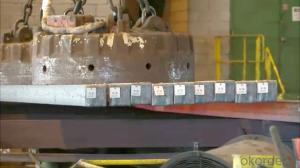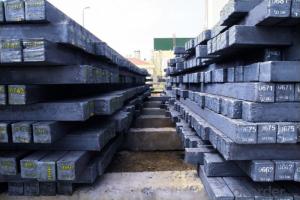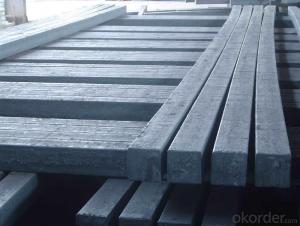Prime Q275 145mm Square Alloy Steel Billet
- Loading Port:
- Shanghai
- Payment Terms:
- TT OR LC
- Min Order Qty:
- 100 m.t.
- Supply Capability:
- 10000 m.t./month
OKorder Service Pledge
OKorder Financial Service
You Might Also Like
Structure of Prime Q275 145mm Square Alloy Steel Billet

Description of Prime Q275 145mm Square Alloy Steel Billet
1. Prepainted steel coil is coated with organic layer, which provides higher anti-corrosion property and a longer lifespan than that of galvanized or galvalume steel sheets.
2. The base metals for prepainted steel coil consist of cold rolled, HDGI Steel, electro-galvanized and hot-dip alu-zinc coated steel. The finish coats of prepainted steel coil can be classified into groups as follows: polyester, silicon modified polyesters, polyvinylidene fluoride, high-durability polyester, etc.
3. The production process has evolved from one-coating-and-one-baking to double-coating-and-double-baking, and even three-coating-and-three-baking.
4. The color of the prepainted steel coil has a very wide selection, like orange, cream-colored, dark sky blue, sea blue, bright red, brick red, ivory white, porcelain blue, etc.
5. The prepainted steel coils can also be classified into groups by their surface textures, namely regular prepainted sheets, embossed sheets and printed sheets.

Main Feature of Prime Q275 145mm Square Alloy Steel Billet
They were one of several reasons for the wind to be taken out of the sails of the recent oil price momentum. Kuwait’s oil minister said that his country would only commit to a production freeze if all major producers are involved, including Iran. We also had Goldman telling us that oil markets will not rebalance at $40/bbl as it throws a lifeline to cash-strapped US producers.
If it is talk of a production freeze that is behind the rally it shows how low expectations have fallen. It is in the nature of oil people to talk the market up. Any bullish crumb is given exaggerated significance and any port in a storm will do. It is all but fact that the oil market will be tighter in the second half of this year when seasonal demand shoots up and US production continues to decline. It was the same picture last year. If OPEC and key non-OPEC production is frozen that will ensure the daily surplus will fall, but in all likelihood there will still be a surplus and there is an enormous global stockbuild to burn off.
Applications of Prime Q275 145mm Square Alloy Steel Billet
A. Corrugated design makes it excellent waterproof performance
B. Materials as prepainted steel sheets, galvanized steel sheets, galvalume (Al-Zn coated sheets) are available to make corrugated sheet.
C.Those material are durable, anti-corrosion in bad weather for 20-30 years based on it's Zinc(Galvanized) coating or AZ (Galvalume) coating.
D. Different shape of the sheet make it suitable for any style of buildings.
E.Easy to install, no need special tools to fix the sheet.
F.Light weight due to high strength to weight ratio of steel. Light weight means easier handling lower shipping costs, easier installation
G. Different color is availbe base on the RAL Standard make your building more beautiful.
H. We will provide the best solutions if you don't have a exact idea of the specification you want for the steel sheet based on your weather conditions, engineering structure, construction budget and so on.

Specifications of Prime Q275 145mm Square Alloy Steel Billet
Product | Billet |
Material Grade | SGCC / SGCH / DX51D+AZ, etc |
Thickness | 0.6-3.0mm |
Width | 500-1500mm |
Tolerance | Thickness: +/-0.02mm , Width:+/-2mm |
Zinc-coating | Z30-150g/m2 |
Technique | Raw material: Hot rolled steel coil --> Cold rolled_>hot dipped galvalume |
Surface | Dried, Chromated, Unoiled |
Spangle | Regular spangle , small spangle, zero spangle |
ID | 508MM 610MM |
Coil weight | 1-25MT |
Export package | Cardboard inner sleeves, Waterproof paper, galvanized steel covered and steel strip packed |
FAQ of Prime Q275 145mm Square Alloy Steel Billet
We have organized several common questions for our clients,may help you sincerely:
1. How Can I Visit There?
Our company is located in Tianjin City, China, near Beijing. You can fly to Tianjin Airport Directly. All our clients, from home or aboard, are warmly welcome to visit us!
2. How Can I Get Some Sample?
We are honored to offer you sample.
- Q:What industries use steel billets?
- Due to their strength, durability, and versatility, steel billets are extensively used in a wide range of industries. The construction industry heavily relies on steel billets for the production of structural components like beams, columns, and girders, which provide vital support and strength in infrastructure projects such as buildings and bridges. In the automotive industry, steel billets are crucial for manufacturing various car parts, including engine components, chassis, and suspension systems. The preference for steel billets in this industry stems from their high strength-to-weight ratio, which enhances fuel efficiency and overall performance. Manufacturing industries like machinery, equipment, and tool production also heavily depend on steel billets. These billets are used to manufacture critical components such as gears, shafts, valves, which require exceptional strength, durability, and precision. Additionally, steel billets play a vital role in the energy sector, particularly in the production of oil and gas pipelines. These pipelines require specific grades of steel billets that can withstand harsh conditions, high pressures, and corrosive environments. Moreover, steel billets have applications in other sectors such as shipbuilding, aerospace, mining, and agriculture. They are widely utilized in any industry where strength, durability, and reliability are paramount. In conclusion, the remarkable mechanical properties of steel billets enable their diverse applications across multiple industries. The demand for steel billets remains strong as they are an indispensable raw material for producing critical components in numerous sectors.
- Q:What are the different packaging options available for steel billets?
- There are several different packaging options available for steel billets, depending on the specific requirements and preferences of the customer. Here are some common packaging options: 1. Wooden Crates: Steel billets can be packaged in wooden crates for protection during transportation and storage. These crates are sturdy and provide a barrier against moisture and physical damage. 2. Steel Frames: Another option is to package the steel billets in steel frames. These frames are typically made of strong and durable steel bars that securely hold the billets in place, providing stability and protection. 3. Plastic Wrapping: Steel billets can also be packaged using plastic wrapping. This method involves wrapping the billets tightly in plastic film, which helps to protect them from dust, moisture, and scratches. 4. Wire Binding: Wire binding is a common packaging option for steel billets. It involves using steel wires to bundle the billets together, providing stability and preventing movement during transportation. 5. Customized Packaging: Some customers may require customized packaging options for their steel billets. This can include using specific materials, such as foam or cardboard, to provide additional protection or incorporating branding elements onto the packaging. Ultimately, the choice of packaging option will depend on factors such as the size and weight of the steel billets, the mode of transportation, and the specific requirements of the customer. It is important to consider factors such as protection, stability, ease of handling, and cost-effectiveness when selecting the most suitable packaging option for steel billets.
- Q:How are steel billets used in the manufacturing of hydraulic systems?
- Steel billets are used in the manufacturing of hydraulic systems as they serve as the raw material for various components. Hydraulic systems require strong and durable parts to withstand the high pressures and forces involved. Steel billets, which are essentially semi-finished steel products, are first heated and then shaped into the desired form through processes like hot rolling or extrusion. These formed steel billets are then further processed to create different hydraulic system components such as cylinders, pistons, valves, and fittings. The use of steel billets provides several advantages in the manufacturing of hydraulic systems. Firstly, steel is known for its high strength and toughness, making it suitable for withstanding the extreme pressures and forces encountered in hydraulic systems. It also offers excellent resistance to corrosion, which is crucial considering the exposure to fluids and harsh environments in hydraulic systems. Furthermore, steel billets can be easily machined and welded, allowing for the creation of intricate and customized hydraulic components. The versatility of steel billets enables the production of various shapes and sizes required for different hydraulic system applications. Overall, steel billets play a vital role in the manufacturing of hydraulic systems by providing a strong, durable, and versatile material for the production of essential components. Their use ensures the reliability and efficiency of hydraulic systems, enabling them to perform their intended functions in various industries such as construction, manufacturing, and transportation.
- Q:What is the role of steel billets in the manufacturing of conveyor belts?
- Steel billets play a crucial role in the manufacturing of conveyor belts. These billets, which are semi-finished products made from molten steel, are the starting point for the production process. Once the steel billets are obtained, they undergo a series of manufacturing steps to transform them into the various components of a conveyor belt. Firstly, the steel billets are heated and then rolled into thin sheets or strips, depending on the desired thickness of the conveyor belt. These sheets are then further processed to create the core structure of the belt. The core structure provides the necessary strength and durability to withstand the demanding conditions of conveyor belt applications. Steel billets are also used to produce the metal reinforcements within the conveyor belt. These reinforcements, usually in the form of steel cords or steel wires, are embedded within the belt to enhance its tensile strength. They prevent the belt from stretching or breaking under heavy loads, ensuring its longevity and reliability. Furthermore, steel billets are utilized to manufacture the belt's pulley system. Conveyor belts rely on pulleys to facilitate the movement of materials along the belt. The pulleys are typically made from solid steel billets that are machined and designed to smoothly guide the belt while maintaining proper tension. In summary, steel billets are vital in the manufacturing of conveyor belts as they serve as the foundation for creating the core structure, reinforcements, and pulleys. Their strength and versatility make them an ideal material for producing conveyor belts that can withstand the rigors of industrial applications, ensuring efficient and reliable material handling processes.
- Q:the ear has burrs, is it the billet problem or the rolling mill problem, will it be caused by the blowhole of the billet?
- The rolling process of rolling mill of hot rolling and cold rolling process for the two step: a hot rolling process: from out of billet steel plant is only semi-finished products, to the rolling mill for rolling, in order to become a qualified product.
- Q:What are the different types of steel billet rolling defects?
- Some of the different types of steel billet rolling defects include surface cracks, scale formation, edge cracks, internal cracks, surface defects (such as pits, scars, and scratches), shape defects (such as bowing, wavy edges, and center buckling), and size defects (such as undersized or oversized billets).
- Q:How are steel billets used in the manufacturing of medical devices?
- Steel billets are used in the manufacturing of medical devices as a raw material for shaping and forming various components. They are often melted down and poured into molds to create intricate shapes and designs required for medical devices such as surgical instruments, implants, and prosthetics. The high strength and durability of steel make it an ideal choice for ensuring the longevity and reliability of these devices, ensuring they can withstand the rigorous demands of medical applications.
- Q:What is the average lead time for ordering steel billets?
- The average lead time for ordering steel billets can vary depending on various factors such as the supplier, quantity required, and current market conditions. However, on average, it can range from a few weeks to a couple of months.
- Q:How do steel billets contribute to the water treatment industry?
- Steel billets are used in the water treatment industry to manufacture various components such as pipes, valves, and fittings. These components are vital for the construction and maintenance of water treatment infrastructure. Steel billets provide the necessary strength, durability, and corrosion resistance needed to withstand harsh conditions and chemicals involved in water treatment processes. Thus, steel billets play a crucial role in ensuring the efficiency and longevity of water treatment systems.
- Q:What are the different production methods for steel billets?
- There are several different production methods for steel billets, including continuous casting, ingot casting, and direct hot rolling. Continuous casting involves pouring molten steel into a water-cooled mold to form a continuous strand, which is then cut into desired lengths. Ingot casting involves pouring molten steel into individual molds to form solid blocks, which are later reheated and rolled into billets. Direct hot rolling involves passing a large steel ingot through a series of rolling mills to reduce its size and shape it into a billet.
1. Manufacturer Overview |
|
|---|---|
| Location | |
| Year Established | |
| Annual Output Value | |
| Main Markets | |
| Company Certifications | |
2. Manufacturer Certificates |
|
|---|---|
| a) Certification Name | |
| Range | |
| Reference | |
| Validity Period | |
3. Manufacturer Capability |
|
|---|---|
| a)Trade Capacity | |
| Nearest Port | |
| Export Percentage | |
| No.of Employees in Trade Department | |
| Language Spoken: | |
| b)Factory Information | |
| Factory Size: | |
| No. of Production Lines | |
| Contract Manufacturing | |
| Product Price Range | |
Send your message to us
Prime Q275 145mm Square Alloy Steel Billet
- Loading Port:
- Shanghai
- Payment Terms:
- TT OR LC
- Min Order Qty:
- 100 m.t.
- Supply Capability:
- 10000 m.t./month
OKorder Service Pledge
OKorder Financial Service
Similar products
New products
Hot products
Hot Searches
Related keywords


































